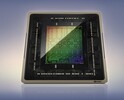NVIDIA GeForce RTX 5090 vs NVIDIA RTX 3500 Ada Generation Laptop GPU vs NVIDIA RTX 2000 Ada Generation Laptop GPU
NVIDIA GeForce RTX 5090
► remove from comparison
The Nvidia GeForce RTX 5090 is a high-end desktop graphics card utilizing the GB202 chip based on the Blackwell architecture. The model offers 170 SMs out of 192 (21,760 CUDA cores), and 32 GB GDDR7 graphics memory with a 512-bit memory bus (1,792 GB/s). The base clock of the GPU (reference model) is specified at 2.01 GHz, while the boost clock can reach 2.41 GHz. RTX 5090 offers 170 RT cores (+42 cores compared to the previous RTX 4090) and 680 5th Gen. Tensor cores.
Architecture
The Nvidia GeForce RTX 5090 features a new Tensor (5th Gen) and RT-cores (4th Gen), with 3352 AI TOPS and 318 TFLOPS respectively. Blackwell architecture is the first to feature the new DLSS 4 Multi Frame generation, which, thanks to enhanced AI capabilities can generate more frames per second while using less memory and delivering better picture quality. Nvidia also improved the performance and output quality of DLSS, Frame Generation, and Ray Reconstruction features (also available for the previous RTX 4000 series). Additionally, the new models now support Reflex 2 low latency mode with Frame Warp.
Performance
Thanks to the new Tensor and RT-cores, as well as a massive bump in CUDA cores, the card is promised (by Nvidia) to offer as much as 2x better performance compared to the previous RTX 4090 (thanks to the new DLSS 4 MFG feature). The RTX 5090 is expected to be the fastest graphics card of 2025 and, presumably will deliver good performance even at 8K.
According to our own benchmarks, the RTX 5090 is 27% faster than the previous RTX 4090 in applications and games (without accounting for RT and DLSS). With the Ray Tracing (Cyberpunk 2077 2.1, DLSS Transformer), gaming performance can be 25% higher compared to the previous flagship model, and DLSS Frame Generation (2x) can deliver even 28% higher FPS. Thanks to the MFG 4x mode the frame counter can be even 2x-4x higher.
Power consumption
According to Nvidia, the GB202 chip is manufactured using the modern 4N FinFET process at TSMC and is specified with a TGP (Total Graphics Power) of 575 Watt (175W higher than RTX 4090). Nvidia now also specifies maximum GPU temperature, which is stated at 90 ℃ for RTX 5090. The model also requires at least 1000 W PSU.
NVIDIA RTX 3500 Ada Generation Laptop GPU
► remove from comparison
The Nvidia RTX 3500 Ada Generation is a higher-end professional graphics card for use in laptops that sports 5,120 CUDA cores and 12 GB of ECC GDDR6 VRAM. Brought into existence in 2023, this graphics adapter leverages TSMC's 5 nm process and Nvidia's Ada Lovelace architecture to achieve higher-than-average performance combined with moderate power consumption. The Nvidia-recommended TGP range for the card is very wide at 60 W to 140 W leading to bizarre performance differences between different systems powered by what is supposed to be the same product.
Hardware-wise, the RTX 3500 is a cut-down GeForce RTX 4070 Desktop, as far as we can tell. Consequently, both make use of the AD104 chip and have little difficulty running triple-A games at QHD 1440p.
Quadro series graphics cards ship with a different BIOS and drivers than GeForce cards and are targeted at professional users rather than gaming. Commercial product design, large-scale calculations, simulation, data mining, 24 x 7 operation, certified drivers - if any of this sounds familiar, then a Quadro card will make you happy.
Architecture and Features
Ada Lovelace brings a range of improvements over older graphics cards utilizing the outgoing Ampere architecture. It's not just a better manufacturing process and a higher number of CUDA cores that we have here (up to 16,384 versus 10,752); under-the-hood refinements are plentiful, including an immensely larger L2 cache, an optimized ray tracing routine (a different wat to determine what is transparent and what isn't is used), and other changes. Naturally, these graphics cards can both encode and decode some of the most widely used video codecs, AVC, HEVC and AV1 included; they also support a host of Nvidia technologies, including Optimus and DLSS 3, and they can certainly be used for various AI tasks.
The RTX 3500 Ada features 40 RT cores of the 3rd generation, 160 Tensor cores of the 4th generation and 5,120 CUDA cores. Multiply those numbers by 1.15 and what you get looks exactly like a desktop RTX 4070: 46, 184 and 5,888, respectively. Elsewhere, the graphics card comes with 12 GB of 192-bit wide ECC GDDR6 memory for a very healthy throughput of ~432 GB/s. Error correction can be turned off if desired. The fact that error correction is present here proves that the RTX 3500 Ada is indeed targeted at professional users.
Just like Ampere-based cards, the RTX 3500 makes use of the PCI-Express 4 protocol. 8K SUHD monitors are supported, however, DP 1.4a video outputs may prove to be a bottleneck down the line.
Performance
With its power target set to ~105 W, the RTX graphics card delivers a Blender 3.3 Classroom CUDA score of 33 seconds which is a pretty good result. Most 2024 games are playable at 2160p on High with this GPU.
Nvidia's marketing materials mention "up to 23 TFLOPS" of performance, a 15% improvement over the 20 TFLOPS that the RTX 3000 Ada Generation is supposedly good for.
Your mileage may vary depending on how competent the cooling solution of your laptop is and how high the TGP power target of the RTX 3500 is. One other thing worth mentioning is that enabling error correction appears to reduce the amount of video memory that is available to applications and games by up to a gigabyte.
Power consumption
Nvidia no longer divides its laptop graphics cards into Max-Q and non-max-Q models. Instead, laptop makers are free to set the TGP according to their needs, and the range can sometimes be shockingly wide. This is the case for the RTX 3500, as the lowest value recommended for it sits at just 60 W while the highest is more than two times higher at 140 W (this most likely includes Dynamic Boost). The slowest system built around an RTX 3500 Ada can easily be 60% slower than the fastest one. This is the kind of delta that we've been seeing on consumer-grade laptops featuring the latest GeForce RTX cards.
Last but not the least, the improved 5 nm process (TSMC 4N) the RTX 3500 is built with makes for very decent energy efficiency, as of mid 2023.
NVIDIA RTX 2000 Ada Generation Laptop GPU
► remove from comparison
The Nvidia RTX 2000 Ada Generation Laptop GPU, not to be confused with the A2000, P2000 or T2000, is a mid-range professional graphics card for use in laptops that sports 3,072 CUDA cores and 8 GB of GDDR6 VRAM. It would be fair to say that this is a GeForce RTX 4060 (Laptop) in disguise; consequently, the former is powered by the same AD107 chip as the latter, and is fast enough to handle any triple-A game at 1080p with Ultra quality settings. Brought into existence in 2023, the RTX 2000 leverages TSMC's 5 nm process and Nvidia's Ada Lovelace architecture to achieve very decent performance combined with moderate power consumption. The Nvidia-recommended TGP range for the card is very wide at 35 W to 140 W leading to bizarre performance differences between different systems powered by what is supposed to be the same product.
Quadro series graphics cards ship with much different BIOS and drivers than GeForce cards and are targeted at professional users rather than gamers. Commercial product design, large-scale calculations, simulation, data mining, 24 x 7 operation, certified drivers - if any of this sounds familiar, then a Quadro card will make you happy.
Architecture and Features
Ada Lovelace brings a range of improvements over older graphics cards utilizing the outgoing Ampere architecture. It's not just a better manufacturing process and a higher number of CUDA cores that we have here (up to 16,384 versus 10,752); under-the-hood refinements are plentiful, including an immensely larger L2 cache, an optimized ray tracing routine (a different way is employed to determine what is transparent and what isn't), and other changes. Naturally, these graphics cards can both encode and decode some of the most widely used video codecs, AVC, HEVC and AV1 included; they also support a host of Nvidia technologies, including Optimus and DLSS 3, and they can certainly be used for various AI applications.
The RTX 2000 features 24 RT cores of the 3rd generation, 96 Tensor cores of the 4th generation and 3,072 CUDA cores. Increase those numbers by 50%, and you get an RTX 3000 Ada Generation - as long as we disregard clock speed differences, of course. Unlike costlier Ada Generation professional laptop graphics cards, the RTX 2000 comes with 8 GB of non-ECC VRAM; the lack of error correction makes this card less suitable for super-important tasks and round-the-clock operation. Much like it is with the RTX 3000 Ada Generation, the VRAM is 128-bit wide and delivers a decent bandwidth of ~256 GB/s.
The RTX 2000 Ada Generation makes use of the PCI-Express 4 protocol, just like Ampere-based cards. 8K SUHD monitors are supported, however, DP 1.4a video outputs can potentially prove to be a bottleneck down the line.
Performance
Most 2024 games are playable at 1440p on High with this GPU. That being said, the average RTX 2000 Ada in our extensive database is much closer to the RTX 4050 Laptop than it is to the RTX 4060 Laptop.
Nvidia's marketing materials mention "up to 14.5 TFLOPS" of performance, a significant downgrade compared to 20 TFLOPS delivered by the RTX 3000 Ada Generation.
Your mileage may vary depending on how competent the cooling solution of your laptop is and how high the TGP power target of the RTX 2000 Ada is.
Power consumption
Nvidia no longer divides its laptop graphics cards into Max-Q and non-max-Q models. Instead, laptop makers are free to set the TGP according to their needs, and the range can sometimes be shockingly wide. This is especially the case for the RTX 2000, as the lowest value recommended for it sits at just 35 W while the highest is 300% higher at 140 W. The slowest system built around an RTX 2000 Ada can easily be half as fast as the fastest one. This is the kind of delta that we've already seen on consumer-grade laptops featuring the latest GeForce RTX cards.
Last but not the least, the improved 5 nm process (TSMC 4N) the Ada graphics card is built with makes for very decent energy efficiency, as of mid 2023.
| NVIDIA GeForce RTX 5090 | NVIDIA RTX 3500 Ada Generation Laptop GPU | NVIDIA RTX 2000 Ada Generation Laptop GPU | |||||||||||||||||||||||||||||||||||||||||||||||||||||||||||||
| RTX Ada Generation Laptop GPU Series |
|
|
| ||||||||||||||||||||||||||||||||||||||||||||||||||||||||||||
| Architecture | Blackwell | Ada Lovelace | Ada Lovelace | ||||||||||||||||||||||||||||||||||||||||||||||||||||||||||||
| Pipelines | 21760 - unified | 5120 - unified | 3072 - unified | ||||||||||||||||||||||||||||||||||||||||||||||||||||||||||||
| TMUs | 680 | 96 | |||||||||||||||||||||||||||||||||||||||||||||||||||||||||||||
| ROPs | 176 | 32 | |||||||||||||||||||||||||||||||||||||||||||||||||||||||||||||
| Raytracing Cores | 170 | 40 | 24 | ||||||||||||||||||||||||||||||||||||||||||||||||||||||||||||
| Tensor / AI Cores | 680 | 160 | 96 | ||||||||||||||||||||||||||||||||||||||||||||||||||||||||||||
| Core Speed | 2010 - 2410 (Boost) MHz | ||||||||||||||||||||||||||||||||||||||||||||||||||||||||||||||
| Theoretical Performance | 104.88 TFLOPS FP32 | 23 TFLOPS FP32 | |||||||||||||||||||||||||||||||||||||||||||||||||||||||||||||
| Cache | L2: 98 MB | L2: 32 MB | |||||||||||||||||||||||||||||||||||||||||||||||||||||||||||||
| Memory Speed | 28000 effective = 1750 MHz | 16000 effective = 2000 MHz | 16000 effective = 2000 MHz | ||||||||||||||||||||||||||||||||||||||||||||||||||||||||||||
| Memory Bus Width | 512 Bit | 192 Bit | 128 Bit | ||||||||||||||||||||||||||||||||||||||||||||||||||||||||||||
| Memory Type | GDDR7 | GDDR6 | GDDR6 | ||||||||||||||||||||||||||||||||||||||||||||||||||||||||||||
| Max. Amount of Memory | 32 GB | 12 GB | 8 GB | ||||||||||||||||||||||||||||||||||||||||||||||||||||||||||||
| Shared Memory | no | no | no | ||||||||||||||||||||||||||||||||||||||||||||||||||||||||||||
| Memory Bandwidth | 1792 GB/s | 432 GB/s | 256 GB/s | ||||||||||||||||||||||||||||||||||||||||||||||||||||||||||||
| API | DirectX 12 Ultimate, OpenGL 4.6, Vulkan 1.4 | DirectX 12 Ultimate, Shader 6.7, OpenGL 4.6, OpenCL 3.0, Vulkan 1.3 | DirectX 12 Ultimate, Shader 6.7, OpenGL 4.6, OpenCL 3.0, Vulkan 1.3 | ||||||||||||||||||||||||||||||||||||||||||||||||||||||||||||
| Transistors | 92.2 Billion | ||||||||||||||||||||||||||||||||||||||||||||||||||||||||||||||
| Die Size | 750 mm² | ||||||||||||||||||||||||||||||||||||||||||||||||||||||||||||||
| technology | 5 nm | 5 nm | 5 nm | ||||||||||||||||||||||||||||||||||||||||||||||||||||||||||||
| PCIe | 5.0 | 4.0 x16 | 4 | ||||||||||||||||||||||||||||||||||||||||||||||||||||||||||||
| Displays | 4 Displays (max.), HDMI 2.1b, DisplayPort 2.1b | 4 Displays (max.), HDMI 2.1, DisplayPort 1.4a | 4 Displays (max.), HDMI 2.1, DisplayPort 1.4a | ||||||||||||||||||||||||||||||||||||||||||||||||||||||||||||
| Features | 4K at 480Hz or 8K at 120Hz with DSC DLSS 4: Super Resolution, DLAA, Ray Reconstruction, Frame Generation, Multi Frame Generation NVIDIA Reflex 2: Low Latency Mode, Frame Warp | ||||||||||||||||||||||||||||||||||||||||||||||||||||||||||||||
| Date of Announcement | 07.01.2025 | 21.03.2023 | 21.03.2023 | ||||||||||||||||||||||||||||||||||||||||||||||||||||||||||||
| Predecessor | NVIDIA GeForce RTX 4090 | RTX A3000 Laptop GPU | RTX A2000 Laptop GPU | ||||||||||||||||||||||||||||||||||||||||||||||||||||||||||||
| Power Consumption | 115 Watt (60 - 115 Watt TGP) | 115 Watt (35 - 115 Watt TGP) | |||||||||||||||||||||||||||||||||||||||||||||||||||||||||||||
| Notebook Size | large | large | |||||||||||||||||||||||||||||||||||||||||||||||||||||||||||||
| Link to Manufacturer Page | images.nvidia.com | images.nvidia.com |
Benchmarks
3DM Vant. Perf. total + NVIDIA GeForce RTX 5090
specvp12 sw-03 + NVIDIA GeForce RTX 5090
Cinebench R15 OpenGL 64 Bit + NVIDIA RTX 3500 Ada Generation Laptop GPU
GFXBench T-Rex HD Offscreen C24Z16 + NVIDIA RTX 2000 Ada Generation Laptop GPU
Average Benchmarks NVIDIA GeForce RTX 5090 → 100% n=43
Average Benchmarks NVIDIA RTX 3500 Ada Generation Laptop GPU → 120% n=43
Average Benchmarks NVIDIA RTX 2000 Ada Generation Laptop GPU → 87% n=43
* Smaller numbers mean a higher performance
1 This benchmark is not used for the average calculation
Game Benchmarks
The following benchmarks stem from our benchmarks of review laptops. The performance depends on the used graphics memory, clock rate, processor, system settings, drivers, and operating systems. So the results don't have to be representative for all laptops with this GPU. For detailed information on the benchmark results, click on the fps number.

Doom: The Dark Ages
2025
Civilization 7
2025
Monster Hunter Wilds
2025
Stalker 2
2024
Until Dawn
2024
God of War Ragnarök
2024
Final Fantasy XVI
2024
Space Marine 2
2024
Star Wars Outlaws
2024
Black Myth: Wukong
2024
Once Human
2024
F1 24
2024
Alone in the Dark
2024
EA Sports WRC
2023
Alan Wake 2
2023
Lords of the Fallen
2023
Total War Pharaoh
2023
Baldur's Gate 3
2023
Lies of P
2023
F1 23
2023
Company of Heroes 3
2023
Returnal
2023
Hogwarts Legacy
2023
Dead Space Remake
2023
F1 22
2022
Cyberpunk 2077 1.6
2022
Far Cry 6
2021
F1 2021
2021
Borderlands 3
2019
Anno 1800
2019
Far Cry New Dawn
2019
Metro Exodus
2019
Far Cry 5
2018
X-Plane 11.11
2018
Dota 2 Reborn
2015
The Witcher 3
2015
GTA V
2015Average Gaming NVIDIA GeForce RTX 5090 → 100%
Average Gaming 30-70 fps → 100%
Average Gaming NVIDIA RTX 3500 Ada Generation Laptop GPU → 44%
Average Gaming 30-70 fps → 27%
Average Gaming NVIDIA RTX 2000 Ada Generation Laptop GPU → 32%
Average Gaming 30-70 fps → 23%
| NVIDIA GeForce RTX 5090 | NVIDIA RTX 3500 Ada Generation Laptop GPU | NVIDIA RTX 2000 Ada Generation Laptop GPU | |||||||||||||||||||
|---|---|---|---|---|---|---|---|---|---|---|---|---|---|---|---|---|---|---|---|---|---|
| low | med. | high | ultra | QHD | 4K | low | med. | high | ultra | QHD | 4K | low | med. | high | ultra | QHD | 4K | ||||
| F1 25 | 122.8 | 80.1 | 40.1 | ||||||||||||||||||
| Doom: The Dark Ages | 171.8 | 137.5 | 89 | ||||||||||||||||||
| The Elder Scrolls IV Oblivion Remastered | 95.4 | 75.9 | 49.7 | ||||||||||||||||||
| Assassin's Creed Shadows | 150 | 139 | 127 | 99 | 87 | 66 | |||||||||||||||
| Civilization 7 | 412 | 381 | 205 | ||||||||||||||||||
| Monster Hunter Wilds | 161.7 | 151.6 | 124 | 112 | 83 | ||||||||||||||||
| Kingdom Come Deliverance 2 | 297 | 218 | 173 | 111 | |||||||||||||||||
| Indiana Jones and the Great Circle | 248 | 212 | 182 | 128 | |||||||||||||||||
| Stalker 2 | 126.6 | 118 | 107 | 78 | |||||||||||||||||
| Call of Duty Black Ops 6 | 227 | 217 | 196 | 148 | |||||||||||||||||
| Until Dawn | 176.9 | 175.5 | 168 | 167 | 145 | 92 | |||||||||||||||
| God of War Ragnarök | 387 | 362 | 300 | 192.7 | |||||||||||||||||
| Final Fantasy XVI | 184.8 | 172.8 | 132 | 87.6 | |||||||||||||||||
| Space Marine 2 | 141 | 137.4 | 130.6 | ||||||||||||||||||
| Star Wars Outlaws | 107 | 103 | 79 | ||||||||||||||||||
| Black Myth: Wukong | 160 | 104 | 87 | 58 | |||||||||||||||||
| Once Human | 382 | 277 | 157.2 | ||||||||||||||||||
| F1 24 | 512 | 263 | 216 | 123 | |||||||||||||||||
| Horizon Forbidden West | 227 | 222 | 189 | 132 | |||||||||||||||||
| Alone in the Dark | 335 | 303 | 267 | 161.3 | |||||||||||||||||
| Avatar Frontiers of Pandora | 193 | 147 | 85 | ||||||||||||||||||
| EA Sports WRC | 218 | 211 | 173.6 | ||||||||||||||||||
| Alan Wake 2 | 198 | 156 | 92 | ||||||||||||||||||
| Lords of the Fallen | 194.2 | 156.3 | 96.4 | ||||||||||||||||||
| Total War Pharaoh | 317.7 | 298.7 | 217.8 | ||||||||||||||||||
| Assassin's Creed Mirage | 222 | 201 | 148 | 113 | 103 | 97 | 76 | 58 | |||||||||||||
| Cyberpunk 2077 2.2 Phantom Liberty | 272 | 272 | 257 | 208 | 195 | 110 | 121.2 | 113.1 | 101.8 | 90.3 | 60.2 | 21.3 | 83 | 63 | 53 | 47 | 30 | ||||
| Baldur's Gate 3 | 347 | 307 | 266 | 176 | 164.8 | 136.2 | 118.6 | 117.3 | 80.2 | 41.2 | 87.1 | 75.7 | 67.6 | 66.1 | 45.6 | ||||||
| Lies of P | 400 | 373 | 222 | ||||||||||||||||||
| Ratchet & Clank Rift Apart | 187.1 | 186 | 149.1 | ||||||||||||||||||
| Company of Heroes 3 | 339 | 316 | 233 | ||||||||||||||||||
| Returnal | 239 | 202 | 139 | ||||||||||||||||||
| Hogwarts Legacy | 157 | 153 | 104 | 101 | 80 | 64 | 53 | 38 | |||||||||||||
| Dead Space Remake | 311 | 224 | 132.1 | ||||||||||||||||||
| The Callisto Protocol | 332.3 | 288 | 241 | 162 | |||||||||||||||||
| Need for Speed Unbound | 289 | 278 | 216 | ||||||||||||||||||
| F1 22 | 209 | 194.3 | 113.3 | 228 | 223 | 182.8 | 72.9 | 48.3 | 24 | 189 | 172 | 129 | 48 | 31 | |||||||
| Far Cry 6 | 254 | 247 | 188 | 157 | 121 | 104 | 87 | 63 | |||||||||||||
| Borderlands 3 | 186 | 189.9 | 168 | ||||||||||||||||||
| Anno 1800 | 147 | 141 | 143 | ||||||||||||||||||
| Far Cry New Dawn | 265 | 256 | 216 | ||||||||||||||||||
| Metro Exodus | 207 | 202 | 166.6 | ||||||||||||||||||
| Shadow of the Tomb Raider | 337 | 321 | 238 | ||||||||||||||||||
| Far Cry 5 | 309 | 304 | 231 | 133 | 135 | 127 | 109 | 62 | 155 | 117 | 109 | 102 | 70 | ||||||||
| X-Plane 11.11 | 241 | 225 | 182 | 152 | 144.6 | 137.8 | 110.9 | 92.7 | 117 | 103 | 81 | ||||||||||
| Final Fantasy XV Benchmark | 235 | 236 | 235 | 235 | 200 | 200 | 167.6 | 128.9 | 97.5 | 54.2 | 180 | 104 | 75 | 56 | |||||||
| Dota 2 Reborn | 360 | 326 | 313 | 264 | 251 | 201 | 177.7 | 162.1 | 153.9 | 134.4 | 167 | 151 | 142 | 134 | |||||||
| The Witcher 3 | 356 | 323 | 380 | 383 | 257 | 159 | 80 | 65 | |||||||||||||
| NVIDIA GeForce RTX 5090 | NVIDIA RTX 3500 Ada Generation Laptop GPU | NVIDIA RTX 2000 Ada Generation Laptop GPU | |||||||||||||||||||
| low | med. | high | ultra | QHD | 4K | low | med. | high | ultra | QHD | 4K | low | med. | high | ultra | QHD | 4K | < 30 fps < 60 fps < 120 fps ≥ 120 fps | 7 | 7 | 20 | 5 39 | 7 39 | 3 14 31 | < 30 fps < 60 fps < 120 fps ≥ 120 fps | 6 | 1 6 | 3 4 | 3 2 | 1 4 | 2 2 2 1 | < 30 fps < 60 fps < 120 fps ≥ 120 fps | 5 6 | 7 4 | 1 7 3 | 3 5 1 | 6 3 | |
For more games that might be playable and a list of all games and graphics cards visit our Gaming List





























